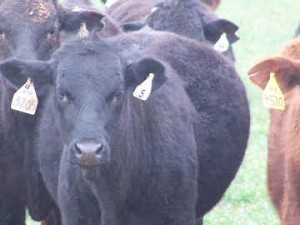 Frothy bloat is the major non-pathogenic source of death loss and lost weight gain in wheat pasture-stocker cattle systems in Texas.
Frothy bloat is the major non-pathogenic source of death loss and lost weight gain in wheat pasture-stocker cattle systems in Texas.
Losses to the stocker cattle and dual-use wheat industries of Texas exceed $20 million per year.
Research we have conducted over the last two years has shown that bloat is a multi-axis problem that no one environmental, animal or management factor catalyses or alleviates.
This research project is being conducted in cooperation with Dr. William E. Pinchak and Dr. Dipti Pitta (Texas AgriLife Research, Vernon)
Rationale
Bloat has historically been associated with lush growth of pasture forage that is low in fiber, high in soluble proteins and moisture. Small grain forages contain high concentrations of highly soluble proteins, yet bloat occurs irregularly in cattle grazing wheat pastures and the specific reasons for its occurrence are not known.
Condensed polyphenolics (tannins) present in certain forage plants reduce bloat incidence because of their ability to bind to soluble proteins and interfere with protein degradation by rumen microbes. Wheat produces tannins and a range of other phenolic compounds that may affect bloat incidence. Phenolic compounds play an important role in plant protection against ultraviolet radiation and oxidative stress; thus, their metabolism may be affected by environmental factors.
The relationships between environmental factors (light quality and intensity, temperature, moisture, soil physics and chemistry) and plant biochemical processes are well known. We hypothesize that specific interactions between light intensity and quality, and temperature may interfere with phenolic compounds synthesis and degradation pathways in wheat forage, affecting the occurrence of bloat in grazing cattle.
Objectives
- Identify the relationships between changes in light and temperature, and phenolic concentration in wheat forage
- Determine the role of phenolic compounds in forage on the activity of rumen microflora and the occurrence of bloat.
Summary of Results
Malinowski, D.P., Kramp, B.A., Min, B.R., Baker, J., Pinchak, W.E., and J.C. Rudd. 2006. Physiological and morphological traits for selection of dual-use wheat with improved forage production. Southern Conservation Systems Conference. 26-28 June 2006. Amarillo, TX.
Funding Sources
Texas AgriLife Research